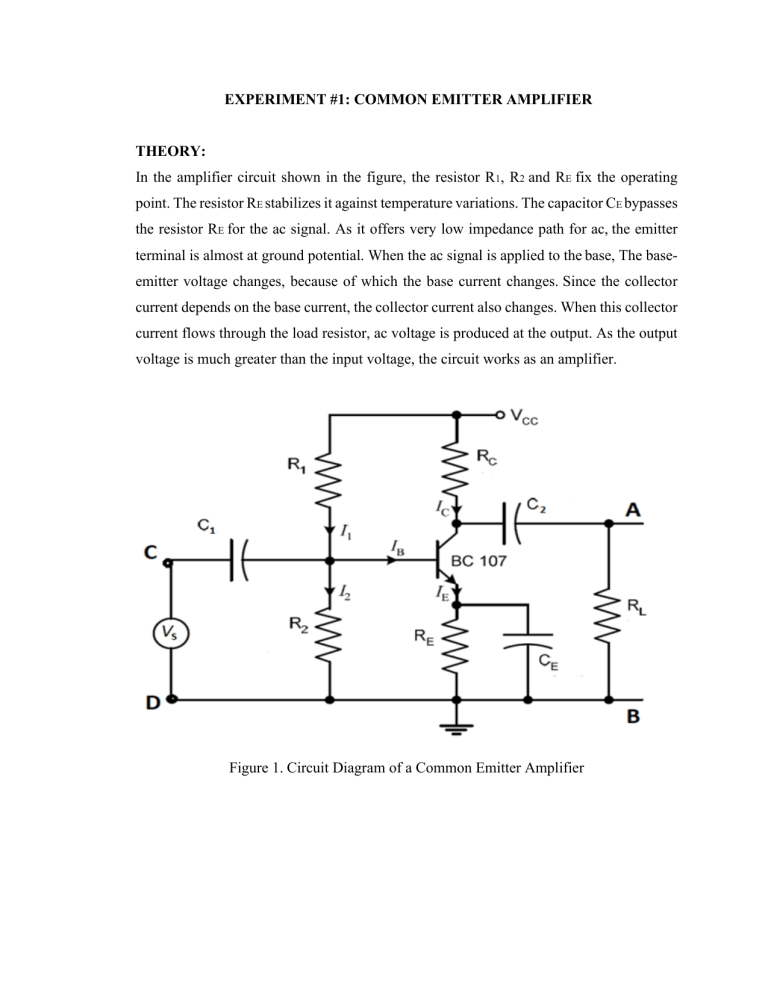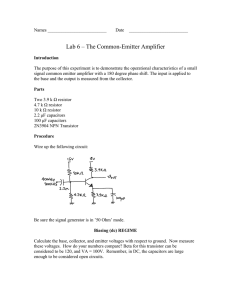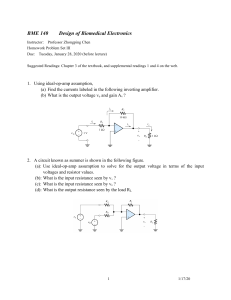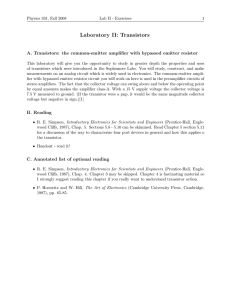
EXPERIMENT #1: COMMON EMITTER AMPLIFIER THEORY: In the amplifier circuit shown in the figure, the resistor R1, R2 and RE fix the operating point. The resistor RE stabilizes it against temperature variations. The capacitor CE bypasses the resistor RE for the ac signal. As it offers very low impedance path for ac, the emitter terminal is almost at ground potential. When the ac signal is applied to the base, The baseemitter voltage changes, because of which the base current changes. Since the collector current depends on the base current, the collector current also changes. When this collector current flows through the load resistor, ac voltage is produced at the output. As the output voltage is much greater than the input voltage, the circuit works as an amplifier. Figure 1. Circuit Diagram of a Common Emitter Amplifier 1. AIM i. Determine the operating point parameters. ii. To study and plot the frequency response curve of CE amplifier. iii. Determine the bandwidth and voltage gain of the amplifier in mid frequency range. 2. APPARATUS REQUIRED i. Regulated DC power supply (12V) ii. Function generator iii. Dual trace oscilloscope iv. Digital multimeter (DMM) 3. COMPONENTS FOR DESIGN i. Transistor BC 107 ii. Resistor R1= 56k Ω, R2= 10K Ω, RC= 2.2K Ω, RE= 500 Ω, RL= 820 Ω - 1 each. iii. Capacitors C1 and C2 = 10F each iv. Capacitor, CE = 100F v. Bread Board & Connecting Wires 4. SPECIFICATIONS: BC 107 (N-P-N) Hfe = 500 at IC= 2mA, VCE = 5V ICBO=15 uA ICM = 200 mA VCEO =45V 5. PROCEDURE TO DETERMINE THE OPERATING POINT PARAMETERS i. Disconnect the signal generator and apply Vcc = 12V. ii. Connect the positive(red) probe of one of the DDM’s to the collector of the transistor and the COM probe to the emitter of the transistor to measure VCE. iii. Connect another DDM in series with resister RC in the circuit to measure the collector current (IC). iv. Ensure that the transistor is operating in the active region by noting that VCE is about half of Vcc. 6. PROCEDURE TO DETERMINE THE FREQUENCY RESPONSE. i. Make the circuit connections as show in figure 1. ii. Set input ac signal at 1KHz using the signal generator and observe the amplified waveform on oscilloscope. Increase the input signal voltage till the output wave shape starts to distort. Measure this input signal voltage. (It’s the maximum signal that the amplifier can amplify without distortion). iii. Set Vs = 50 mVp-p using the signal generator (sinusoidal signal is applied). iv. Keeping the input voltage constant, vary the frequency from 20Hz in steps as provided in the table and note down the corresponding output voltage. 7. RESULTS i. Operating point parameters ii. Frequency response 1. Determine the maximum signal that can be handled by the amplifier without introducing distortion at the input frequency of 1KHz. 2. Plot the graph of gain vrs frequency as shown in figure 2. 3. 4. 5. 6. Lower cutoff frequency, fL = Upper cutoff frequency, fH = Voltage gain at mid-frequency Vo/Vs = Find the band width = fH - fL Figure 2. Frequency Response of Common Emitter Amplifier Vs = ……………….(p-p)(mV) GAIN (dB) FREQUENCY(Hz) Vo(p-p) (mV) 20 30 40 50 100 200 500 700 1k 20k 30k 40k 50k 70k 100k Vo/Vs 20log (Vo/Vs) 200k 500k 1M 10M 50M 200M 500M 1G



